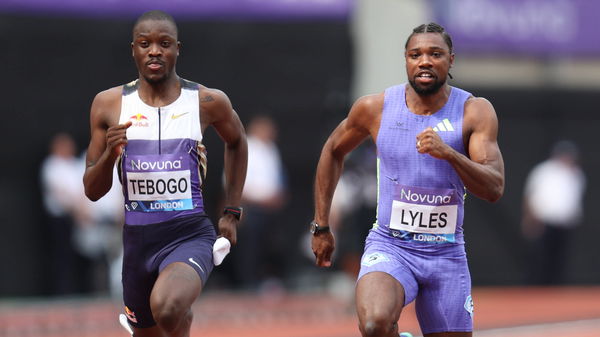
Imago
Credits: Instagram/@nojo18

Imago
Credits: Instagram/@nojo18
Noah Lyles has been racing in Diamond League stadiums since 2017, and almost every September, his dominance becomes more evident. The American sprinter extended his winning streak in Zurich, where he overtook Olympic champion Letsile Tebogo in the final stretch to seize his sixth DL win in the men’s 200 meters. The margin was two hundredths of a second: 19.74 to 19.76.
Watch What’s Trending Now!
The Zurich race carried the tension of their growing rivalry. Tebogo, who stunned the athletics world at the Paris Games by defeating Lyles in a championship 200, returned to the start line intent on holding off the world champion. For 150 meters, he seemed in command. Yet as the curve unwound into the straight, Lyles gathered pace and moved past him with characteristic composure. Meanwhile, Alexander Ogando finished third in 20.14.
With that victory, Lyles secured his place as the only sprinter in history to win six Diamond League titles at 200 meters. And his fiancée, Junelle Bromfield, couldn’t hold back on reposting World Athletics’ acknowledgement of Noah Lyles’ win. The caption read: “6time diamond league champ ❤️❤️🔥🔥.”
ADVERTISEMENT
Noah’s run of consecutive crowns began in Brussels in 2017 and has continued through London, Paris, and Lausanne. “Started in Brussels back in 2017. 5x Diamond League titles later, I’m still here. Going for number 6 tonight. 200m,” he wrote on his Instagram account before the Zurich final. The post served as a reminder of how long his hold on the event has lasted.
Across these eight seasons, Noah Lyles has collected 23 individual Diamond League victories in the 200 meters. He has broken meeting records in Monaco, Lausanne, and Paris, the latter a night in 2019 when he surpassed Usain Bolt’s meeting mark with 19.51. He has also marked his own standards several times, including a 19.50 in Lausanne that stood as one of the fastest performances ever recorded. These are not isolated wins but part of a body of work that reflects both consistency and progression.
View this post on Instagram
ADVERTISEMENT
The Zurich final also signaled what lies ahead.
“My road to defending my world titles in Tokyo in September goes through London,” Lyles said earlier in the season, confirming his commitment to the build-up races. He pointed to London as a venue where he has often produced fast times and did it again in July. And now, his appearance in Zurich demonstrated that his form has remained aligned with that plan for Tokyo.
ADVERTISEMENT
For Tebogo, the narrow loss was both disappointment and encouragement. He equaled his season’s best of 19.76 and once more showed he can press Lyles to the line. Their contests in London, Budapest, Paris, and now Zurich form the spine of a rivalry that defines the men’s 200 meters. What separates them remains experience and the ability to close a race under pressure.
In Zurich, Lyles proved that even when pushed by the rising star, his hold on the Diamond League crown is not yet broken. And now, it’s time to tell how the contest between Noah Lyles and Letsile Tebogo pans out in the future.
ADVERTISEMENT
Noah Lyles and Letsile Tebogo redefine the 200m with contrasting speed and precision
In the question of supremacy over 200 meters, Noah Lyles and Letsile Tebogo represented two contrasting philosophies of sprinting.
Lyles thrived on calculation, a gradual rise from the curve into the straight, while Tebogo pursued immediacy, drawing upon his top-end speed earlier in the race. Their differing executions produced a rivalry measured not only by times on the clock but by the manner in which those times were constructed.
Top Stories
Falcons Owner Arthur Blank Makes Double Firing Decision as Locker Room Stands Against Raheem Morris’ Exit

Cowboys Star Faces NFL Discipline For Jaxson Dart Incident Against Giants

NFL Makes Final Punishment Decision on Shedeur Sanders Incident in Week 17

49ers’ Deommodore Lenoir Goes on Expletive-Laced Rant Against Troy Aikman After Criticism From Cowboys Legend

Kyle Whittingham Cuts Ties With Wink Martindale & Five Michigan Coaches in Major Shake-Up

Kirk Cousins Announces Return Stance With Falcons After Atlanta’s Four-Game Win Streak


Imago
London, England, July 19th 2025: Letsile Tebogo of Botswana, Noah Lyles of United States, Oblique Seville of Jamaica compete in the Men s 100m during the 2025 Novuna London Athletics Meet at London Stadium in London, England Alexander Canillas/SPP PUBLICATIONxNOTxINxBRAxMEX Copyright: xAlexanderxCanillas/SPPx spp-en-AlCa-9U2A8909
Lyles’s reputation as the finest curve runner of his generation had been well established.
ADVERTISEMENT
At the 2022 USATF Outdoor Championships, he demonstrated that skill by gaining decisive ground against Erriyon Knighton before emerging into the straight. His ability to lean into the bend without loss of momentum allowed him to conserve energy and deliver what became his hallmark: The final 50 meters. With a personal best of 19.31 seconds, the third-fastest ever recorded, Lyles consistently produced stronger back-half splits, evidence of his superior endurance and refined transition technique.
Tebogo, in contrast, relied upon his willingness to attack from the outset.
ADVERTISEMENT
His 19.46 in Paris reflected that strategy, with an early surge that placed him beyond Lyles’s closing reach on that occasion. The difference lay in how their races unfolded. Tebogo committed to his speed before the straight, accepting the risk of deceleration, while Lyles preferred to build toward the finish, trusting in the strength of his final drive.
In the balance between curve mastery and raw mid-race velocity, Lyles carried the advantage of structure, while Tebogo carried the advantage of immediacy. The question of who was faster, therefore, depended less upon absolute time and more upon the stage of the race being examined. Track enthusiasts would now wait to know whether superior curve running and closing strength can outweigh raw mid-race velocity yet again.
ADVERTISEMENT
ADVERTISEMENT
ADVERTISEMENT

